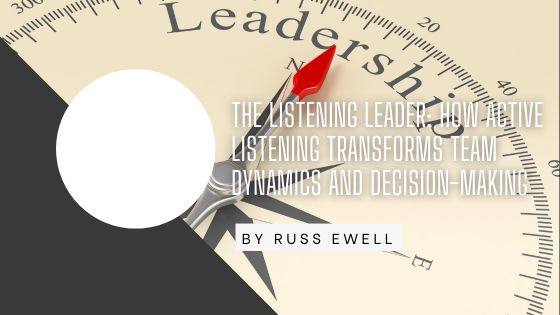Leadership is often associated with giving direction, setting vision, and speaking with confidence. But some of the most effective leaders aren’t the ones who talk the most—they’re the ones who listen best. Active listening is one of the most underrated but powerful tools in a leader’s toolkit. It builds trust, improves team dynamics, and leads to smarter, more inclusive decision-making.
What Is Active Listening?
Active listening goes beyond simply hearing words. It means giving your full attention, observing nonverbal cues, asking clarifying questions, and responding in a way that shows you genuinely understand and value what’s being said. It’s a conscious effort to be present and engaged—without interrupting, judging, or jumping to solutions too quickly.
For leaders, active listening isn’t just a communication skill—it’s a leadership strategy.
Why It Matters
In environments where speed and productivity are emphasized, the habit of truly listening can fall by the wayside. But when leaders take the time to listen deeply, several transformative outcomes occur:
-
Stronger Relationships: People want to feel heard. When leaders listen, team members feel respected, valued, and understood. This builds psychological safety and fosters a culture of openness.
-
Better Decisions: Active listening surfaces diverse perspectives that might otherwise go unheard. This leads to more well-rounded, informed decisions—and often, solutions that reflect the needs and insights of the whole team.
-
Conflict Prevention: Many workplace conflicts stem from misunderstandings or feeling dismissed. Listening early and often can defuse tension before it escalates.
-
Higher Engagement: When people know their ideas and concerns matter, they’re more invested. Teams become more collaborative, motivated, and willing to take ownership.
What Listening Looks Like in Practice
-
Put Away Distractions: Close the laptop, silence the phone, and make eye contact. Give the speaker your full attention to signal that what they’re saying is important.
-
Pause Before Responding: Don’t rush to fill silence or jump in with solutions. Give people time to fully express themselves before offering input.
-
Reflect and Clarify: Paraphrase what you heard and ask clarifying questions. This ensures understanding and shows that you’re engaged.
-
Acknowledge Emotions: Sometimes, people need to feel heard emotionally before they can engage intellectually. Validate feelings without judgment.
-
Follow Through: Listening is only half the job. Acting on what you hear—whether it’s adjusting a plan or offering support—builds credibility.
The Ripple Effect
Listening leaders model behavior that spreads throughout the organization. When team members see that listening is valued, they begin to listen to each other more closely as well. This creates a more empathetic, communicative, and resilient culture.
Conclusion
In a world full of noise, the ability to listen with intention is a superpower. Leaders who embrace active listening don’t just gather more information—they build better relationships, unlock deeper insights, and make decisions that truly reflect the needs of their people. In the long run, it’s not always the loudest voice that leads—it’s the one that hears everyone else.
